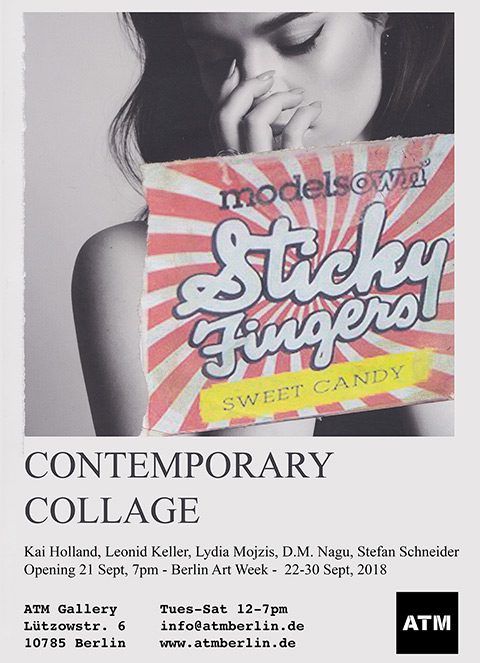exhibitions
Berlin Art Week 2018 – STICKY FINGERS – Contemporary Collage @ ATM Gallery Berlin
On the occasion of Berlin Art Week 2018, ATM Gallery Berlin welcomes you to the group exhibition “Sticky Fingers” with contemporary, analogue collages by Berlin artists Stefan Schneider, Lydia Mojzis, Kai Holland, D.M. Nagu and the artist duo Leonid Keller at the exhibition opening on Friday, 21 September from 7pm.
STICKY FINGERS
Collage, as a technique of imagination and a process of invention, has played a crucial role in the artistic creation of images over the last 100 years. Conceived as a revolt against painting as an art of imitation, collage has, since Cubism, represented the mind’s ability to grasp several aspects of an object simultaneously. It is also a means by which artists incorporate reality into a painting without imitating it. At a time when the term “cut and paste” refers more often to digital operations than to the use of scissors and glue, it seems essential to examine this central process. The selection of these 5 Berlin artists exemplifies how unique and diverse contemporary collage art is between painting and photography, between craft and the mediated reality of our time, and what an important role it continues to play in the art world.
Kai Holland
As the chief photo editor of a well-known picture agency, Kai Holland sits directly at the source of inspiration for his artistic work – for Holland weaves what he sees every day into fantastic hidden object pictures of crude creatures, monstrous machine parts and filigree flying objects. The clusters of his detailed and mannered found objects are graphic cabinets of wonders of an obsessive collagist, in whose subtle and humorous gaze the dilemma of the cycle of creation and destruction is revealed. www.kaiholland.de
Stefan Schneider
Stefan Schneider’s artistic passions are old papers, found poster remnants and tattered magazines. Almost every piece of cellulose that allows us to share its individual history is an artefact for Schneider, which he gives a new task and statement in a different environment. Following the credo of Minimal Art, Schneider’s current works have a level of impact that often transcends borders through their reduction to simple structures, geometric elements and clear forms. www.dasherrschneider.de
Lydia Mojzis
“Parts of female bodies, textile textures, landscapes and geometric shapes are motifs that appeal to me and that I break down to the lowest common denominator,” says Lydia Mojzis. For the young artist and art therapist, each composition is the consequence of exploring a huge selection of images and their possible combinations. “Fixing means to decide, to commit. Simplicity is very important in this.” For Mojzis herself, it is primarily formal aesthetic references that reflect her subjective view of the world. By assembling the set pieces of her environment, Lydia Mojzis constructs a reality that is more coherent for herself. www.lydiamojzis.de
Leonid Keller
Julia Ossko and Eugen Schulz have been working together as the artist couple Leonid Keller since 2013.thematically, they have a strong passion for their personal history, which takes place between the socialist, former USSR and capitalist North America. These influences are the background of the fictional character Leonid Keller, behind which they hide as real figures. Their installations are almost exclusively created in situ, in specific locations around the world, and draw their dramaturgy and magic from the site-specific materials the artists draw upon to create them. Collage, assemblage, drawing, photography and printing are immanent components of the artistic process, which examines the surrounding social structures and at the same time reflects the traditions and political conditions of the respective location, both in its history and in contemporary terms. www.leonidkeller.com
D.M. Nagu
D.M. Nagu usually organises his collages in series, often following a conceptual approach. With a background as a linguist and cultural scientist, D.M. Nagu reduces the meaning of the images to abstraction in the process of cutting them up, in order to then create new contexts and meaning based also on the material characteristics of the paper in the act of collaging or assembling. In this way, he explores the question of originality in the face of an inexhaustible flood of analogue and digital images, and even in the process creates surprisingly touching and impressive compositions full of emotional power. www.d-m-nagu.de




